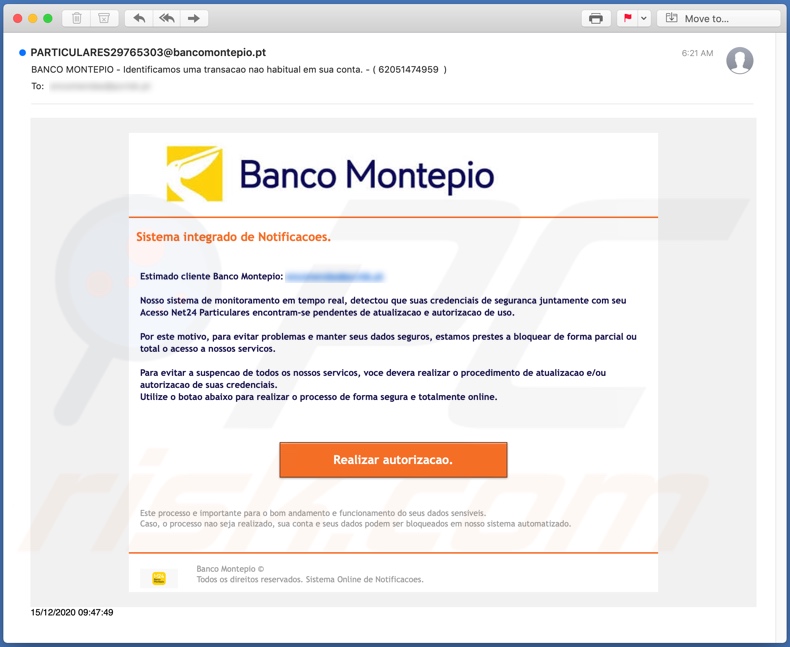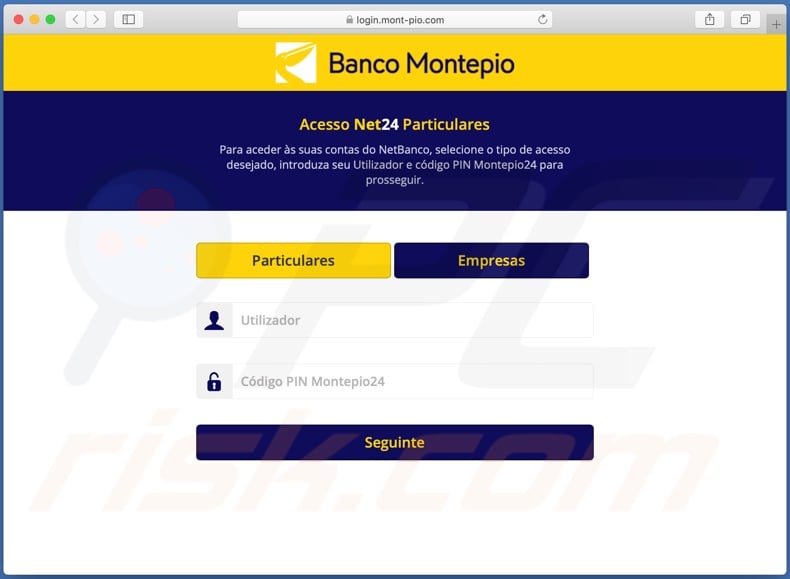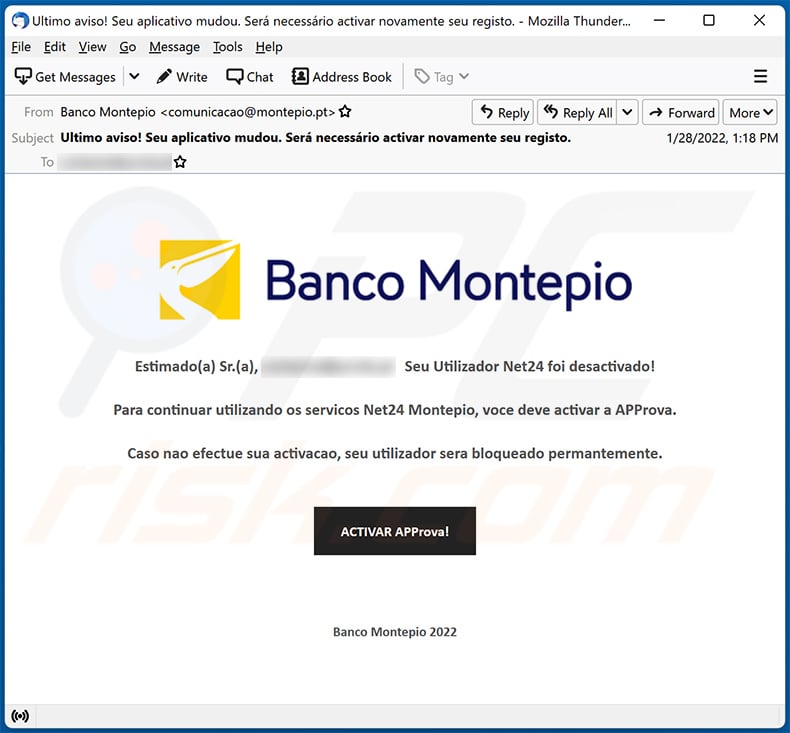Avoid being scammed by fake "Banco Montepio" emails
Phishing/ScamAlso Known As: Banco Montepio spam
Get free scan and check if your device is infected.
Remove it nowTo use full-featured product, you have to purchase a license for Combo Cleaner. Seven days free trial available. Combo Cleaner is owned and operated by RCS LT, the parent company of PCRisk.com.
What is the fake "Banco Montepio" email?
"Banco Montepio email scam" refers to a spam campaign, designed to extract recipients' banking credentials (i.e. usernames and PIN codes / passwords). The term "spam campaign" is used to define a mass-scale operation, during which thousands of deceptive emails are sent.
The messages distributed through this spam campaign, inform recipients that unusual transactions have been detected on their banking accounts and they must update account security to prevent them from being suspended.
These scam emails are disguised as notifications from Banco Montepio, a Portuguese banking and mutual savings organization. In fact, the fake messages are in no way associated with the Montepio bank.
The goal of this scam is to trick users into attempting to log-in to their banking accounts via a link provided in the emails, which leads to a phishing website.

According to a rough translation, the "Banco Montepio" scam messages with the subject/title, "Subject: BANCO MONTEPIO - Identificamos uma transacao nao habitual em sua conta. - ( 62051474959 )" (this may vary), inform recipients that the bank's monitoring system has detected that their security credentials and Private Net24 Access need to be updated and authorized.
Supposedly, until the update/authorization process is carried out, the banking account will be fully or partially suspended. The emails then urge recipients to click the "Realizar autorizacao." button to securely access their accounts and complete the necessary processes.
This link redirects to a phishing website, which is presented as the sign-in page to the Montepio bank. Should any of the log-in credentials be entered into the site, they will be exposed to the scammers behind the bogus emails, thereby, allowing the criminals access and control over users' banking accounts. The stolen accounts could then be used to make fraudulent monetary transactions and/or online purchases.
To summarize, by trusting the fake "Banco Montepio" letters, users could lose access to their bank accounts and experience financial losses, severe privacy issues and even identity theft.
If attempts to sign-in through the phishing webpage have already been made, you are strongly advised to change the credentials of the potentially compromised account and contact the bank's official support.
| Name | Banco Montepio Email Scam |
| Threat Type | Phishing, Scam, Social Engineering, Fraud |
| Fake Claim | Emails claim recipients need to update their bank accounts to avoid them being suspended |
| Disguise | Banco Montepio |
| Related Domains | mont-pio[.]com |
| Serving IP Address (mont-pio[.]com) | 104.24.96.58 |
| Symptoms | Unauthorized online purchases, changed online account passwords, identity theft, illegal access of the computer. |
| Distribution methods | Deceptive emails, rogue online pop-up ads, search engine poisoning techniques, misspelled domains. |
| Damage | Loss of sensitive private information, monetary loss, identity theft. |
| Malware Removal (Windows) |
To eliminate possible malware infections, scan your computer with legitimate antivirus software. Our security researchers recommend using Combo Cleaner. Download Combo CleanerTo use full-featured product, you have to purchase a license for Combo Cleaner. 7 days free trial available. Combo Cleaner is owned and operated by RCS LT, the parent company of PCRisk.com. |
"Email verification", "Zoom email scam", "Google Forms email scam" and "National UK Lottery" are some examples of other phishing spam campaigns. Deceptive/Scam emails are usually presented as "important", "urgent", "priority" and similar. They might even be disguised as mail from legitimate institutions, organizations, companies, service providers and other entities.
As well as phishing, spam campaigns are also used for other types of scams and malware proliferation. Due to the relative prevalence of spam mail, you are advised to exercise caution with incoming emails.
How do spam campaigns infect computers?
Systems are infected via malicious files distributed through spam campaigns. These files can be attached and/or linked inside the emails. Infectious files can be in various formats (e.g. Microsoft Office and PDF documents, archive and executable files, JavaScript, etc.).
When these files are executed, run or otherwise opened, the infection process (i.e. malware download/installation) is triggered. For example, Microsoft Office documents (e.g. "Invoice_24077.xlsb") cause infections by executing malicious macro commands.
In Microsoft Office versions released prior to 2010, malware download/installation begins when an infectious document is opened, however, newer versions have "Protected View" mode that prevents automatic execution of macros. Instead, users are asked to enable macro commands (i.e., to enable editing/content) and hence infection processes can only be started by manually enabling macros.
How to avoid installation of malware?
To avoid malware spread via spam mail, you are strongly advised against opening suspicious or irrelevant emails, especially those with any attachments or links present within them.
Additionally, use Microsoft Office versions released after 2010. Malicious programs also proliferate through untrusted download channels (e.g. unofficial and free file-hosting sites, Peer-to-Peer sharing networks and other third party downloaders), illegal software activation ("cracking") tools, and fake updaters.
Therefore, only download from official/verified sources and activate and update software with tools/functions provided by legitimate developers.
To ensure device integrity and user privacy, have a reputable anti-virus/anti-spyware suite installed and kept updated. Furthermore, use these programs to run regular system scans and to remove detected/potential threats.
If you have already opened malicious attachments, we recommend running a scan with Combo Cleaner Antivirus for Windows to automatically eliminate infiltrated malware.
Text presented in the "Banco Montepio" scam email message:
Subject: BANCO MONTEPIO - Identificamos uma transacao nao habitual em sua conta. - ( 62051474959 )
Sistema integrado de Notificacoes.
Estimado cliente Banco Montepio: ********
Nosso sistema de monitoramento em tempo real, detectou que suas credenciais de seguranca juntamente com seu Acesso Net24 Particulares encontram-se pendentes de atualizacao e autorizacao de uso.
Por este motivo, para evitar problemas e manter seus dados seguros, estamos prestes a bloquear de forma parcial ou total o acesso a nossos servicos.
Para evitar a suspencao de todos os nossos servicos, voce devera realizar o procedimento de atualizacao e/ou autorizacao de suas credenciais.
Utilize o botao abaixo para realizar o processo de forma segura e totalmente online.
Realizar autorizacao.
Este processo e importante para o bom andamento e funcionamento do seus dados sensiveis.
Caso, o processo nao seja realizado, sua conta e seus dados podem ser bloqueados em nosso sistema automatizado.
Banco Montepio ©
Todos os direitos reservados. Sistema Online de Notificacoes.
15/12/2020 09:47:49
Screenshot of the phishing website, disguised as the sign-in page of Banco Montepio:

Another example of Banco Montepio-themed spam email promoting a phishing site:

Text presented within:
Subject: Ultimo aviso! Seu aplicativo mudou. Será necessário activar novamente seu registo.
Banco MontepioEstimado(a) Sr.(a), - Seu Utilizador Net24 foi desactivado!
Para continuar utilizando os servicos Net24 Montepio, voce deve activar a APProva.
Caso nao efectue sua activacao, seu utilizador sera bloqueado permantemente.
ACTIVAR APProva!Banco Montepio 2022
Instant automatic malware removal:
Manual threat removal might be a lengthy and complicated process that requires advanced IT skills. Combo Cleaner is a professional automatic malware removal tool that is recommended to get rid of malware. Download it by clicking the button below:
DOWNLOAD Combo CleanerBy downloading any software listed on this website you agree to our Privacy Policy and Terms of Use. To use full-featured product, you have to purchase a license for Combo Cleaner. 7 days free trial available. Combo Cleaner is owned and operated by RCS LT, the parent company of PCRisk.com.
Quick menu:
- What is Banco Montepio spam?
- Types of malicious emails.
- How to spot a malicious email?
- What to do if you fell for an email scam?
Types of malicious emails:
![]() Phishing Emails
Phishing Emails
Most commonly, cybercriminals use deceptive emails to trick Internet users into giving away their sensitive private information, for example, login information for various online services, email accounts, or online banking information.
Such attacks are called phishing. In a phishing attack, cybercriminals usually send an email message with some popular service logo (for example, Microsoft, DHL, Amazon, Netflix), create urgency (wrong shipping address, expired password, etc.), and place a link which they hope their potential victims will click on.
After clicking the link presented in such email message, victims are redirected to a fake website that looks identical or extremely similar to the original one. Victims are then asked to enter their password, credit card details, or some other information that gets stolen by cybercriminals.
![]() Emails with Malicious Attachments
Emails with Malicious Attachments
Another popular attack vector is email spam with malicious attachments that infect users' computers with malware. Malicious attachments usually carry trojans that are capable of stealing passwords, banking information, and other sensitive information.
In such attacks, cybercriminals' main goal is to trick their potential victims into opening an infected email attachment. To achieve this goal, email messages usually talk about recently received invoices, faxes, or voice messages.
If a potential victim falls for the lure and opens the attachment, their computers get infected, and cybercriminals can collect a lot of sensitive information.
While it's a more complicated method to steal personal information (spam filters and antivirus programs usually detect such attempts), if successful, cybercriminals can get a much wider array of data and can collect information for a long period of time.
![]() Sextortion Emails
Sextortion Emails
This is a type of phishing. In this case, users receive an email claiming that a cybercriminal could access the webcam of the potential victim and has a video recording of one's masturbation.
To get rid of the video, victims are asked to pay a ransom (usually using Bitcoin or another cryptocurrency). Nevertheless, all of these claims are false - users who receive such emails should ignore and delete them.
How to spot a malicious email?
While cyber criminals try to make their lure emails look trustworthy, here are some things that you should look for when trying to spot a phishing email:
- Check the sender's ("from") email address: Hover your mouse over the "from" address and check if it's legitimate. For example, if you received an email from Microsoft, be sure to check if the email address is @microsoft.com and not something suspicious like @m1crosoft.com, @microsfot.com, @account-security-noreply.com, etc.
- Check for generic greetings: If the greeting in the email is "Dear user", "Dear @youremail.com", "Dear valued customer", this should raise suspiciousness. Most commonly, companies call you by your name. Lack of this information could signal a phishing attempt.
- Check the links in the email: Hover your mouse over the link presented in the email, if the link that appears seems suspicious, don't click it. For example, if you received an email from Microsoft and the link in the email shows that it will go to firebasestorage.googleapis.com/v0... you shouldn't trust it. It's best not to click any links in the emails but to visit the company website that sent you the email in the first place.
- Don't blindly trust email attachments: Most commonly, legitimate companies will ask you to log in to their website and to view any documents there; if you received an email with an attachment, it's a good idea to scan it with an antivirus application. Infected email attachments are a common attack vector used by cybercriminals.
To minimise the risk of opening phishing and malicious emails we recommend using Combo Cleaner Antivirus for Windows.
Example of a spam email:

What to do if you fell for an email scam?
- If you clicked on a link in a phishing email and entered your password - be sure to change your password as soon as possible. Usually, cybercriminals collect stolen credentials and then sell them to other groups that use them for malicious purposes. If you change your password in a timely manner, there's a chance that criminals won't have enough time to do any damage.
- If you entered your credit card information - contact your bank as soon as possible and explain the situation. There's a good chance that you will need to cancel your compromised credit card and get a new one.
- If you see any signs of identity theft - you should immediately contact the Federal Trade Commission. This institution will collect information about your situation and create a personal recovery plan.
- If you opened a malicious attachment - your computer is probably infected, you should scan it with a reputable antivirus application. For this purpose, we recommend using Combo Cleaner Antivirus for Windows.
- Help other Internet users - report phishing emails to Anti-Phishing Working Group, FBI’s Internet Crime Complaint Center, National Fraud Information Center and U.S. Department of Justice.
Share:

Tomas Meskauskas
Expert security researcher, professional malware analyst
I am passionate about computer security and technology. I have an experience of over 10 years working in various companies related to computer technical issue solving and Internet security. I have been working as an author and editor for pcrisk.com since 2010. Follow me on Twitter and LinkedIn to stay informed about the latest online security threats.
PCrisk security portal is brought by a company RCS LT.
Joined forces of security researchers help educate computer users about the latest online security threats. More information about the company RCS LT.
Our malware removal guides are free. However, if you want to support us you can send us a donation.
DonatePCrisk security portal is brought by a company RCS LT.
Joined forces of security researchers help educate computer users about the latest online security threats. More information about the company RCS LT.
Our malware removal guides are free. However, if you want to support us you can send us a donation.
Donate
▼ Show Discussion